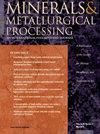The ultimate mineral processing challenge: Recovery of rare earths, phosphorus and uranium from Florida phosphatic clay
Q2 Materials Science
引用次数: 15
Abstract
Phosphate beneficiation in Florida generates more than one tonne of phosphatic clay, or slime, per tonne of phosphate rock produced. Since the start of the practice of large-scale washing and desliming for phosphate beneficiation, more than 2 Gt of slime has accumulated, containing approximately 600 Mt of phosphate rock, 600 kt of rare earth elements (REEs) and 80 million kilograms of uranium. The recovery of these valuable elements from the phosphatic clay is one of the most challenging endeavors in mineral processing, because the clay is extremely dilute, with an average solids concentration of 3 percent, and fine in size, with more than 50 percent having particle size smaller than 2 µm, and it contains nearly 50 percent clay minerals as well as large amounts of magnesium, iron and aluminum. With industry support and under funding from the Critical Materials Institute, the Florida Industrial and Phosphate Research Institute in conjunction with the Oak Ridge National Laboratory undertook the task to recover phosphorus, rare earths and uranium from Florida phosphatic clay. This paper presents the results from the preliminary testing of two approaches. The first approach involves three-stage cycloning using cyclones with diameters of 12.4 cm (5 in.), 5.08 cm (2 in.) and 2.54 cm (1 in.), respectively, to remove clay minerals followed by flotation and leaching. The second approach is a two-step leaching process. In the first step, selective leaching was conducted to remove magnesium, thus allowing the production of phosphoric acid suitable for the manufacture of diammonium phosphate (DAP) in the second leaching step. The results showed that multistage cycloning with small cyclones is necessary to remove clay minerals. Selective leaching at about pH 3.2 using sulfuric acid was found to be effective for removing more than 80 percent of magnesium from the feed with minimal loss of phosphorus.矿物加工的终极挑战:从佛罗里达磷化粘土中回收稀土、磷和铀
在佛罗里达州,每生产一吨磷矿,就会产生一吨以上的磷粘土或黏液。自开始大规模洗脱磷矿选矿以来,已积累了超过20亿吨的矿泥,其中含有约6亿吨磷矿,6万吨稀土元素(ree)和8000万公斤铀。从磷酸盐粘土中回收这些有价值的元素是矿物加工中最具挑战性的工作之一,因为粘土非常稀,平均固体浓度为3%,粒度细小,超过50%的粘土粒度小于2微米,它含有近50%的粘土矿物以及大量的镁、铁和铝。在工业界的支持和关键材料研究所的资助下,佛罗里达工业和磷酸盐研究所与橡树岭国家实验室联合开展了从佛罗里达磷粘土中回收磷、稀土和铀的任务。本文介绍了两种方法的初步测试结果。第一种方法包括使用直径分别为12.4厘米(5英寸)、5.08厘米(2英寸)和2.54厘米(1英寸)的旋风分离器进行三级旋流,去除粘土矿物,然后进行浮选和浸出。第二种方法是两步浸出过程。在第一步中,进行选择性浸出以去除镁,从而在第二步浸出生产适合制造磷酸二铵(DAP)的磷酸。结果表明,要去除粘土矿物,必须采用小旋风分离器多级旋流。研究发现,在pH约为3.2的条件下,使用硫酸进行选择性浸出,可以有效地去除饲料中80%以上的镁,同时磷的损失最小。
本文章由计算机程序翻译,如有差异,请以英文原文为准。
求助全文
约1分钟内获得全文
求助全文
来源期刊

Minerals & Metallurgical Processing
工程技术-矿业与矿物加工
CiteScore
0.84
自引率
0.00%
发文量
0
审稿时长
>12 weeks
期刊介绍:
For over twenty-five years, M&MP has been your source for the newest thinking in the processing of minerals and metals. We cover the latest developments in a wide range of applicable disciplines, from metallurgy to computer science to environmental engineering. Our authors, experts from industry, academia and the government, present state-of-the-art research from around the globe.
 求助内容:
求助内容: 应助结果提醒方式:
应助结果提醒方式:


